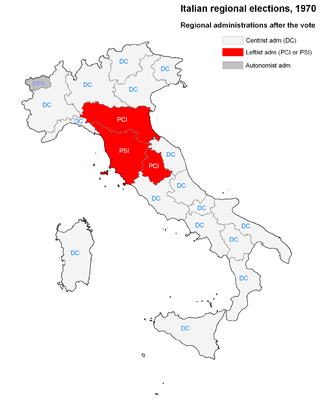 |
|---|
|
The Ligurian regional election of 1990 took place on 6 and 7 May 1990.

 |
|---|
|
The Ligurian regional election of 1990 took place on 6 and 7 May 1990.

Christian Democracy and the Italian Communist Party lost many votes, especially to Ligurian Union and the Greens. After the election Christian Democrat Giacomo Gualco formed a government with the Italian Socialist Party and their centrist allies (Pentapartito). In 1992 Glauco was replaced by Edmondo Ferrero, to whom Giancarlo Mori succeeded in 1994 with a centre-left majority.
 | ||||
| Parties | votes | votes (%) | seats | |
|---|---|---|---|---|
| Italian Communist Party | 330,029 | 28.4 | 12 | |
| Christian Democracy | 320,412 | 27.5 | 12 | |
| Italian Socialist Party | 163,512 | 14.1 | 6 | |
| Northern League Liguria | 71,311 | 6.1 | 2 | |
| Greens (Federation of Green Lists + Rainbow Greens) | 66,740 | 5.7 | 2 | |
| Italian Republican Party | 47,728 | 4.1 | 1 | |
| Italian Social Movement | 39,276 | 3.4 | 1 | |
| Italian Liberal Party | 34,930 | 3.0 | 1 | |
| Italian Democratic Socialist Party | 26,503 | 2.3 | 1 | |
| Pensioners' Party | 20,942 | 1.8 | 1 | |
| Antiprohibitionists on Drugs | 16,429 | 1.4 | 1 | |
| Hunting Fishing Environment | 13,484 | 1.2 | - | |
| Proletarian Democracy | 12,000 | 1.0 | - | |
| Total | 1,163,296 | 100.0 | 40 | |
Source: Ministry of the Interior

The politics of Italy are conducted through a parliamentary republic with a multi-party system. Italy has been a democratic republic since 2 June 1946, when the monarchy was abolished by popular referendum and a constituent assembly was elected to draft a constitution, which was promulgated on 1 January 1948.

Christian Democracy was a Christian democratic political party in Italy. The DC was founded on 15 December 1943 in the Italian Social Republic as the ideal successor of the Italian People's Party, which had the same symbol, a crusader shield. As a Catholic-inspired, centrist, catch-all party comprising both centre-right and centre-left political factions, the DC played a dominant role in the politics of Italy for fifty years, and had been part of the government from soon after its inception until its final demise on 16 January 1994 amid the Tangentopoli scandals. Christian Democrats led the Italian government continuously from 1946 until 1981. The party was nicknamed the "White Whale" due to its huge organization and official color. During its time in government, the Italian Communist Party was the largest opposition party.

Liguria is a region of north-western Italy; its capital is Genoa. Its territory is crossed by the Alps and the Apennines mountain range and is roughly coextensive with the former territory of the Republic of Genoa. Liguria is bordered by France to the west, Piedmont to the north, and Emilia-Romagna and Tuscany to the east. It rests on the Ligurian Sea, and has a population of 1,557,533. The region is part of the Alps–Mediterranean Euroregion.

The Christian Democratic Centre was a Christian-democratic political party in Italy from 1994 to 2002. Formed from a right-wing split from Christian Democracy, the party joined the centre-right coalition, and was a member of the European People's Party (EPP).

Ligurian or Genoese is a Gallo-Italic language spoken primarily in the territories of the former Republic of Genoa, now comprising the area of Liguria in Northern Italy, parts of the Mediterranean coastal zone of France, Monaco, the village of Bonifacio in Corsica, and in the villages of Carloforte on San Pietro Island and Calasetta on Sant'Antioco Island off the coast of southwestern Sardinia. It is part of the Gallo-Italic and Western Romance dialect continuum. Although part of Gallo-Italic, it exhibits several features of the Italo-Romance group of central and southern Italy. Zeneize, spoken in Genoa, the capital of Liguria, is the language's prestige dialect on which the standard is based.

Italian irredentism in Nice was the political movement supporting the annexation of the County of Nice to the Kingdom of Italy.

Lega Liguria, whose complete name is Lega Liguria per Salvini Premier, is a regionalist political party active in Liguria. Established in 1987, it was one of the founding "national" sections of Lega Nord (LN) in 1991 and has been the regional section of Lega per Salvini Premier (LSP) in Liguria since 2020.

This page gathers the results of elections in Liguria.

The Ligurian regional election of 1970 took place on 7–8 June 1970.

The Ligurian regional election of 1975 took place on 15 June 1975.

The Ligurian regional election of 1980 took place on 8 June 1980.

The Ligurian regional election of 1985 took place on 12 May 1985.

The Italian regional elections of 1970 were held on 7 and 8 June. Even if the regional system was conceived by the Italian Constitution in 1948, the five autonomous regions were the sole to be immediately established. The fifteen ordinary regions were indeed created in 1970 with the first elections.

The Italian regional elections of 1975 were held on 15 and 16 June. The fifteen ordinary regions, created in 1970, elected their second assemblies. Following the 1971 census, Piedmont, Veneto and Lazio had ten more seats each.

The Italian regional elections of 1980 were held on 8 and 9 June. The fifteen ordinary regions, created in 1970, elected their third assemblies.

The Italian regional elections of 1985 were held on 12 and 13 May. The fifteen ordinary regions, created in 1970, elected their fourth assemblies.

The Italian Social Movement was a neo-fascist political party in Italy. A far-right party, it presented itself until the 1990s as the defender of Italian fascism's legacy, and later moved towards national conservatism. In 1972, the Italian Democratic Party of Monarchist Unity was merged into the MSI and the party's official name was changed to Italian Social Movement – National Right.

The Italian regional elections of 1990 were held on 6 and 7 May. The fifteen ordinary regions, created in 1970, elected their fifth assemblies.

The Ligurian regional election of 2015 took place on 31 May 2015.